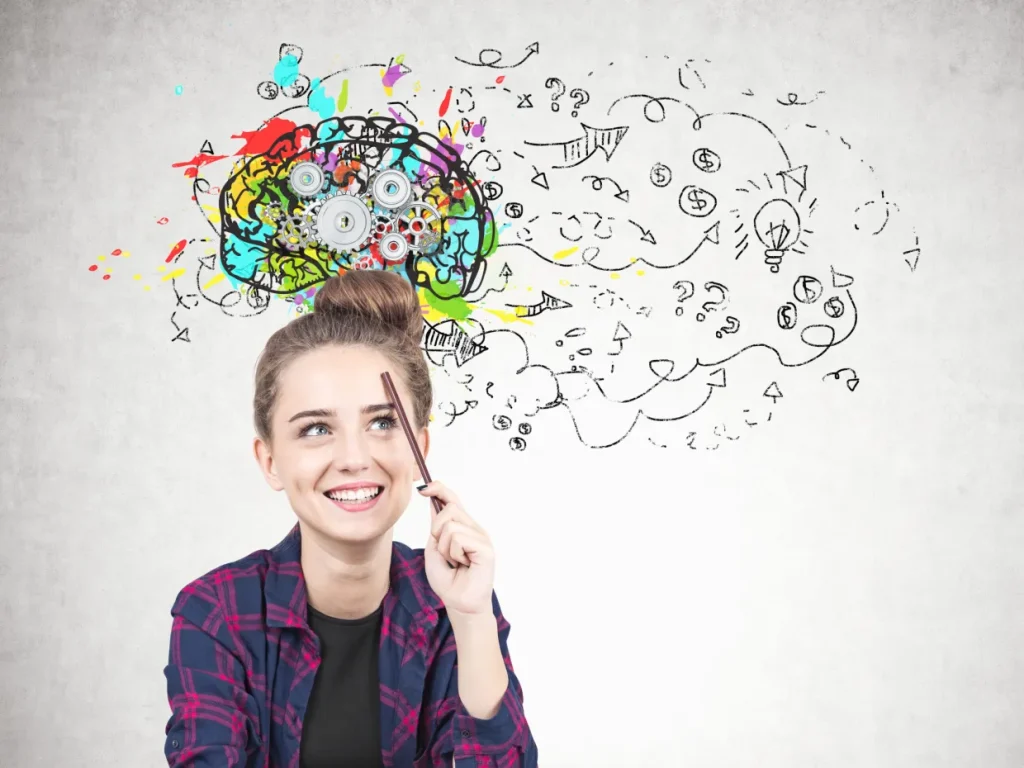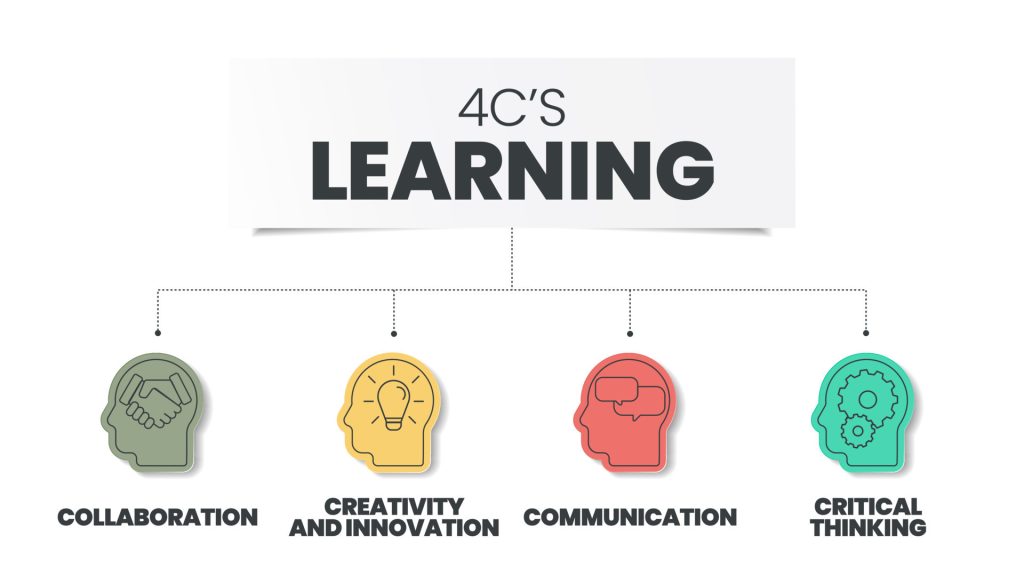Creativity is coming up with new and valuable ideas by thinking in different ways. It’s not just copying what’s already there, but making something fresh and useful. Creative people often connect things that don’t seem related and find unique solutions to problems, making the world more interesting and innovative.
Creativity is crucial in the 4Cs framework because it brings new and clever ideas, making things better. It helps solve problems in smart ways and lets us adapt to changes easily. In communication and collaboration, creativity makes things more interesting and expressive.
The 4Cs framework includes four important skills. Communication is Sharing ideas and understanding others. Collaboration Working together to achieve common goals. Critical Thinking analyzing information and making smart decisions. Creativity is thinking creatively and coming up with new ideas.
Role of Creativity in Communication

The role of creativity in communication is crucial for fostering engagement, expressiveness, innovation, and meaningful connections.
Engagement
Creative communication captures the audience’s attention and sustains their interest. Engaging content, whether through compelling storytelling, vivid imagery, or unique presentation styles, draws people in and encourages active participation.
Expressiveness
Creativity allows for a diverse range of expression beyond conventional methods. Through creative language, visual elements, and multimedia, individuals can convey complex ideas in ways that are vivid, compelling, and easily understood.
Innovation
Creative communication introduces innovative approaches to conveying messages. It encourages thinking outside traditional boundaries, leading to the development of novel communication strategies and the exploration of new mediums and platforms.
Connection
Creative communication establishes a deeper connection with the audience. By tapping into emotions, creating relatable narratives, and incorporating elements that resonate with the audience, communicators can build a stronger bond, fostering understanding and empathy.
Problem-Solving
Creativity in communication extends to problem-solving, where unique and imaginative solutions can be proposed and conveyed effectively. It enables individuals to address challenges with a fresh perspective, encouraging a culture of innovation within teams and organizations.
Adaptability
Creative communication allows for adaptability in various contexts and across different audiences. It enables communicators to tailor their messages to suit diverse preferences, cultural nuances, and changing circumstances, ensuring relevance and effectiveness.
Enhanced Memory
Creative elements, such as storytelling, humor, or visual aids, enhance memory retention. Information presented creatively and memorably is more likely to be recalled, reinforcing the effectiveness of the communication.
Creativity and Collaboration

Creativity and collaboration go hand in hand, playing complementary roles in fostering innovation and achieving common goals. Here’s an overview of the relationship between creativity and collaboration:
Idea Generation
Creativity enhances collaboration by contributing diverse and innovative ideas to the collective brainstorming process. Collaborative environments benefit from the creative input of individuals who can offer unique perspectives and solutions.
Team Dynamics
Creative collaboration builds a positive team dynamic where members feel encouraged to express their ideas freely. A creative atmosphere promotes open communication and a willingness to explore unconventional approaches to problem-solving.
Innovative Solutions
Collaboration allows creative ideas to be refined and developed collectively, leading to more robust and innovative solutions. Teams that foster a collaborative and creative culture can address challenges in ways that may not be possible through individual efforts alone.
Cross-Pollination of Ideas
Creative collaboration encourages the cross-pollination of ideas, where individuals with different skills and perspectives contribute to a richer pool of concepts. This interdisciplinary approach often leads to more comprehensive and imaginative outcomes.
Adaptability
Creative collaboration promotes adaptability within a team, allowing members to respond flexibly to changing circumstances. The combination of creative thinking and collaborative problem-solving enables teams to navigate challenges and find dynamic solutions.
Shared Vision
Creativity helps in crafting a shared vision within a collaborative setting, aligning team members toward common objectives. When individuals contribute creatively to a shared goal, they feel a sense of ownership and commitment to the collaborative process.
Communication
Creative collaboration improves communication by encouraging diverse forms of expression.
Teams that embrace creativity often find innovative ways to communicate ideas, ensuring that information is conveyed effectively and understood by all members.
Motivation and Engagement
Creative collaboration enhances motivation and engagement as team members feel inspired by the shared creative process. Working together on creative projects can boost morale and foster a positive and supportive team culture.
Developing Creative Skills

Developing creative skills involves cultivating a mindset that encourages imaginative thinking, problem-solving, and innovative expression.
- Embrace Curiosity: Encourage a curious mindset by exploring new topics, asking questions, and seeking to understand the world from different perspectives. Foster a lifelong love of learning and an openness to new ideas.
- Divergent Thinking Exercises: Engage in activities that promote divergent thinking, where multiple solutions or ideas are explored. Practice brainstorming sessions, mind mapping, and other techniques that encourage a broad range of creative possibilities.
- Cross-Disciplinary Exploration: Explore diverse fields and disciplines to gain inspiration from different sources. Connect ideas from seemingly unrelated areas to generate innovative solutions or concepts.
- Play and Experimentation: Embrace a playful attitude and engage in activities that encourage experimentation. Playfulness fosters a relaxed and open mindset, allowing creative ideas to emerge more freely.
- Develop Observation Skills: Sharpen observational skills by paying attention to details in the environment. Observe patterns, behaviors, and occurrences that might serve as inspiration for creative endeavors.
- Creative Challenges: Set personal creative challenges to stretch your thinking and problem-solving abilities. Challenge yourself to find alternative solutions or create something new within constraints.
- Mindfulness and Reflection: Practice mindfulness to enhance self-awareness and reflection. Reflect on personal experiences, thoughts, and emotions to fuel creative expression.
- Collaborative Projects: Engage in collaborative projects to benefit from the diverse perspectives and ideas of others. Collaborations often spark creativity and lead to the synthesis of unique concepts.
Conclusion
Creativity is like the secret ingredient in the 4Cs mix—Communication, Collaboration, Critical Thinking, and Creativity. It’s not just about making art; it’s about coming up with cool ideas and solving problems in smart ways. When we talk and work together, creativity makes things more interesting, like adding spice to a recipe.
It’s the key to making messages memorable and turning teams into super-creative squads. Whether we’re figuring out new solutions or just making everyday things more fun, creativity is the magic that ties it all together. So, let’s keep being curious, trying new stuff, and thinking outside the box.



